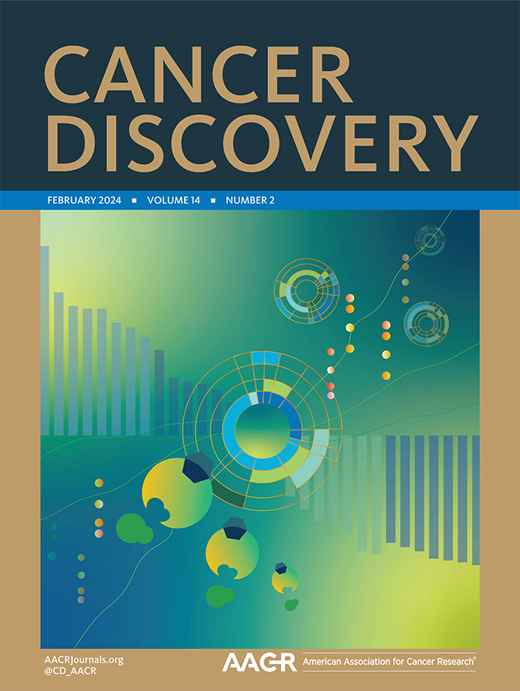表达hpv16的肿瘤释放多种IL-1配体来协调全身免疫抑制,其破坏使治疗性疫苗有效
IF 33.3
1区 医学
Q1 ONCOLOGY
引用次数: 0
摘要
有症状的癌症通过结合肿瘤微环境抑制适应性免疫来逃避免疫破坏。此外,宫颈癌和其他癌症的小鼠模型显示,肿瘤能够系统性地诱导中性粒细胞的扩增,从而削弱脾脏和淋巴结中t细胞的发育,进一步损害免疫反应。现在我们发现,人乳头瘤病毒16型(HPV16)驱动的宫颈和皮肤鳞状细胞肿瘤向循环系统释放四种免疫调节配体——IL-1α、IL-1β、IL-33和IL-36β,这些配体使骨髓偏向于粒细胞性骨髓生成,产生免疫抑制中性粒细胞,填充脾脏和肿瘤。一种IL-1家族辅助受体拮抗剂,抗il - 1rap,消除了这种中性粒细胞的扩增,并补充了无效的hpv16e7肽疫苗,以引发有效的抗肿瘤免疫应答,该应答被抗ctla -4进一步维持。人类宫颈肿瘤中il -1驱动的系统性免疫抑制的证据鼓励对这种组合治疗策略进行评估,以治疗一种很大程度上免疫逃避的癌症类型。意义:宫颈癌是全球妇女癌症死亡的第四大原因。虽然这种疾病是由两种抗原病毒癌蛋白驱动的,但由于全身免疫抑制,治疗性疫苗已被证明无效。这项研究阐明了一种可行的机制,其破坏使癌蛋白疫苗有效,具有转化潜力。本文章由计算机程序翻译,如有差异,请以英文原文为准。
HPV16-Expressing Tumors Release Multiple IL-1 Ligands to Orchestrate Systemic Immunosuppression Whose Disruption Enables Efficacy of a Therapeutic Vaccine
It is well-established that symptomatic cancers evade immune destruction by coalescing tumor microenvironments to suppress adaptive immunity. Additionally, mouse models of cervical and other cancers have revealed a capability of tumors to systemically induce the expansion of neutrophils that cripple T-cell development in spleen and lymph nodes, further impairing immune responses. Now we show that human papillomavirus type 16 (HPV16)–driven squamous cell tumors in the cervix and skin release into the circulatory system four immunoregulatory ligands – IL-1α, IL-1β, IL-33, and IL-36β – that bias the bone marrow toward granulocytic myelopoiesis, producing immunosuppressive neutrophils populating spleens and tumors. An IL-1 family coreceptor antagonist, anti-IL1RAP, abrogates this neutrophil expansion and complements an otherwise inefficacious HPV16 E7 peptide vaccine to elicit an effective antitumor immune response that is further sustained by anti–CTLA-4. Evidence for similarly IL-1–driven systemic immunosuppression in human cervical tumors encourages evaluation of this combinatorial therapeutic strategy for treating a largely immunoevasive cancer type. Significance: Cervical cancer is the fourth leading cause of cancer deaths in women worldwide. Although the disease is driven by two antigenic viral oncoproteins, therapeutic vaccines have proved ineffective, inferentially due to systemic immunosuppression. This study elucidated an actionable mechanism, whose disruption renders an oncoprotein vaccine efficacious, with translational potential.
求助全文
通过发布文献求助,成功后即可免费获取论文全文。
去求助
来源期刊

Cancer discovery
ONCOLOGY-
CiteScore
22.90
自引率
1.40%
发文量
838
审稿时长
6-12 weeks
期刊介绍:
Cancer Discovery publishes high-impact, peer-reviewed articles detailing significant advances in both research and clinical trials. Serving as a premier cancer information resource, the journal also features Review Articles, Perspectives, Commentaries, News stories, and Research Watch summaries to keep readers abreast of the latest findings in the field. Covering a wide range of topics, from laboratory research to clinical trials and epidemiologic studies, Cancer Discovery spans the entire spectrum of cancer research and medicine.
 求助内容:
求助内容: 应助结果提醒方式:
应助结果提醒方式:


